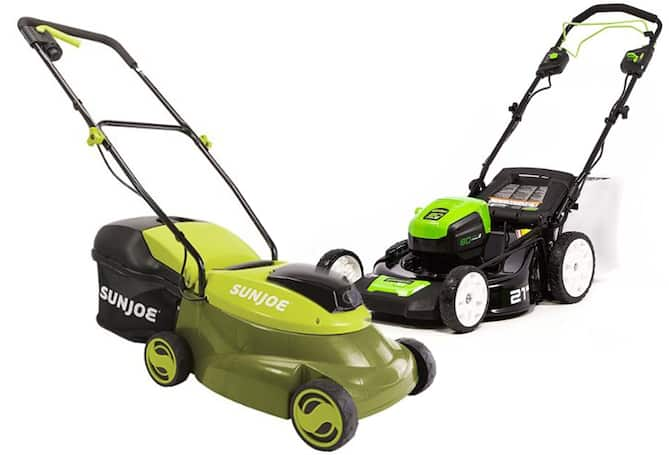Gas vs Electric Power Tools: How to Choose the Best Type for Your Needs

Best Selling Products carousel(5 Items)
Tips on how to equip your garage or tool shed in style
Compared to hand tools, power tools require minimal effort to operate and save you time and energy when completing cleaning, installation and renovation tasks. Power tools rely on attached or built-in power sources that drive their motors and improve their efficiency. A comprehensive power tool buying guide classifies these pieces of equipment by their power sources and differentiates those relying on internal combustion engines (gas), compressed air and electric motors.
Most power tools used in manufacturing, at construction sites and at home run on gas or electric power sources, depending on what’s most conducive to the work being done. For example, if you're looking for the right lawn mowers, trimmers and leaf blowers you'll consider the features of gas vs. electric yard tools. Each of these equipment classes has its benefits and drawbacks and the best power source to choose depends on several factors, including the task at hand, where it will be used most often, and the amount of power required.
Consider the power demand
When reading a power tool buying guide, you'll quickly learn that gas-powered tools generally deliver more power than electric ones. It's worth noting that there are two types of electric power tools: corded and cordless models. Corded units are plug-in models that draw continuous power from wall outlets, while cordless units have built-in or replaceable rechargeable batteries. While the cordless design is common with handheld power tools such as drills and saws, it's also available for bigger equipment like mowers. Plug-in power tools are usually more powerful than cordless ones while gas-powered tools have greater horsepower overall. However, some corded tools can generate as much power as some of their gas-reliant counterparts.
While gas power tools are generally more powerful, keep in mind that the additional power provided by a gas tool is often unneeded for smaller household tasks. But when considering which is better: battery or gas lawn mowers, the job is larger and might benefit from one or the other. For example, routine lawn mowing only requires an electric mower. However, overgrown lawns with thick bushes and tall grass may need the superior power of a gas lawn mower.
Think about ease of use
Ease of use should be a top priority when you're considering gas vs electric yard tools and other power equipment. Ease of use includes numerous factors ranging from the weight and heft of a tool to how convenient it is for completing the task at hand. Electric power tools are generally lighter than gas ones. This makes them easier to move around and maneuver at work. Cordless electric tools are easier to use than corded models because they're not tethered to wall outlets. You can take them anywhere and use them out in the yard away from the house.
A cordless electric drill, for example, is ideal for a job site without readily available power. Similarly, a cordless lawn mower is easier to move around a yard than a corded one as it has no cord to get in the way and can cut to the farthest corner in the yard because it doesn’t need to plug into an outdoor wall outlet. Convenience is a big factor when considering which is better: battery or gas lawn mower? In addition to being heavier, a gas-powered mower requires that you pull its starter cord to turn it on. This takes more effort than pushing the power switch on an electric model.
Duration of use is important
How quickly you need to complete given tasks is imperative for choosing the right equipment. Gas-powered tools usually run longer than battery-powered ones because fuel has a higher energy density than batteries. Therefore, gas power tools are better suited for extended outdoor work. If you have a large yard, settle the battery-powered lawn mower vs gas model debate by going with the latter.
While battery-powered tools and garage equipment have shorter runtimes, it's possible to mitigate this drawback by having extra battery packs on hand and ready to swap. The extra cost of replacement batteries is worth considering when weighing the pros and cons of gas vs electric tools. Furthermore, replacing batteries may introduce downtimes that make the task at hand take longer than planned. For indoor tasks, a corded or plug-in electric power tool provides superior runtime benefit to both gas- and battery-powered equipment. Using power from an outlet means your tool will run as long as you need without recharging or refueling.
Consider the environment
Don't forget maintenance time and costs
Maintenance is a big part of running powered equipment and should feature prominently in your purchasing decision. Electric power tools are easier to maintain than gas-powered ones. Maintenance costs for electric models are also usually lower. With gas powered tools, you need to change oil, replace oil filters, clean up oil spills, clean and replace spark plugs, fix ripped pull cords and make cable adjustments. These maintenance needs don't apply to electric power tools.
Maintaining an electric power tool requires replacing the batteries (if battery-powered); repairing and replacing motor brushes (brushless electric motors don't require this maintenance); replacing frayed cords; and sharpening blades, drill bits and other metal parts (applies to both gas and electric models).
Consider power output, ease of use, environmental impact and maintenance when comparing gas vs electric yard tools and power equipment. Make sure to give more weight to the factors you deem important when making your selection. Use this power tool buying guide as a handy reference to find the right tools for routine tasks and big jobs.